‘Winter’s Bone’ is a film released in 2010 and directed by Debra Granik.
The film tells the story of Ree Dolly, a 17 year old girl who lives in the rural Ozark mountains area of Missouri. Ree’s mother is so ill that she is incapable of looking after the family, so this task is left to Ree who cares for her two younger siblings and the house as best she can. They live in extreme poverty and Ree struggles to feed the family and the animals.
Like may people in this poor area, Lee’s father illegally makes crystal meth and has been summoned to court. However, he disappears leaving his family with no support. The local sheriff informs Ree that her father posted their property as bail and if he does not appear at the courthouse, they will lose the property and have to move elsewhere. It falls to Ree to find her father.
The film is the story of how Ree goes about trying to find her father. In doing this she calls on various members of the community, some of whom are distantly related to Ree. They very reluctantly help her, but also make clear that she shouldn’t be asking too many questions.
Ultimately, she tries to confront the local ‘big man’, ominously called Thump, about her father. Instead of being able to speak with him, Ree is confronted by Thump’s wife who tells her not to bother Thump and to go home and accept that her father has to live with the consequences of some of his actions. Ree does not accept this and tries to make a direct plea to Thump, which fails. Ree is taken by Thump’s wife and a number of other female members of the family, into a barn where they beat her up. Ree’s uncle, Teardrop, arrives on the scene and manages to negotiate that they leave her alone provided Ree stops asking so many questions.
In a bizarre turn of events, Thump’s wife and cohorts arrive at Ree’s house and reveal that Ree’s father is dead, presumably murdered. They take her to a lake where the body has been dumped. In a grizzly scene, Ree pulls her father’s arms out of the water and one of the woman uses a chainsaw to cut the hands from the body – to use as proof that Ree’s father is dead. If Ree is able to prove that he is dead, then they will not lose the house.
Ree goes to the sheriff and tells him that someone put her father’s hands on the porch, thus saving the family house.
What I found interesting with this film is that it had the potential to hype up the poverty, the criminality of the drug trade and the violence of the society, but instead, it chose to skirt on the borders of these themes and in so doing, poignantly bring them to the viewers’ attention. The film never quite makes a judgment on the society it portrays and yet there are some scenes that pass a powerful message about dysfunctional families, the role of men and woman in this society and the ‘pride versus need to survive’ conflict that poverty has created.
It is clear from the beginning that Ree and those who live in the same area are poor. The mise-en-scene for the opening shots makes abundantly clear that this is the case;
- broken machinery and cars in the yard
- children playing outside wearing threadbare clothing
- children’s hair cut very badly
- broken plastic toys lying around
- house in disrepair
- no garden, just dirt
- dog is chained up
- towels on the washing line very old
The colours are all cold blue and grey and slightly washed out.
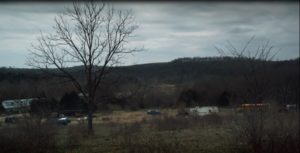
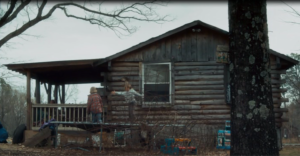
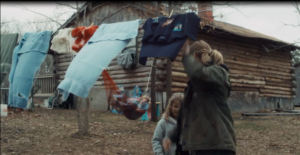
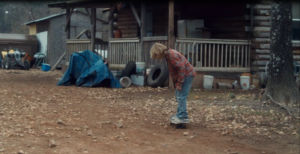
The theme that interested me the most was the role of men and woman in the society. At the start of the film, it seemed that the woman were the practical, sensible ones who kept the families together. Whereas the men appeared almost neurotically irrational and hinting at violence.
When Ree first goes to her best friend for help, she asks if she can use their pick-up truck to go looking for her father. The friend says no; that the truck belongs to her husband. Although not overt, there is the sense that if the friend disobeyed, the husband would become violent.
The same thing happens when Ree goes to her aunt for help. Her uncle, who has the most bizarre name – Teardrop – has an air about him that indicates his tendency towards violence. When Ree arrives her aunt says that they should be quiet because Teardrop is ‘still laying on the bed’. Later when he comes into the kitchen and tells Ree to stop asking the wrong kinds of questions, he does so while loading and unloading a gun. When Ree continues to push, Teardrop grabs her around the neck/jaw and comes very close to her face while telling her that he will not listen any more. Although he doesn’t do anything to Ree, it is as if he is barely containing himself.
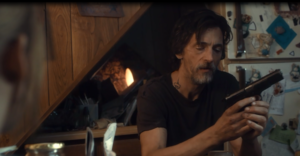
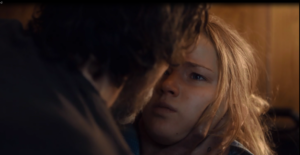
Through out the film, there is this sense that the men are conforming to a role that requires them to be tough, aggressive and intimidating. However, as the film progresses, Ree yet again tries her luck to far and attempts to approach Thump directly to ask about her father. She had been told not to do this. Thump’s wife and woman family members are the ones who then take Ree to the barn and beat her up. Although surprising that the woman displayed this level of violence, it made sense. If the men had beaten her up, it would have forced people like Teardrop and other male family members to retaliate because that would be what society demanded of them if they were ‘real men’. In effect, the woman who beat up Ree were helping her (in a bizarre way) by not allowing the situation to escalate.
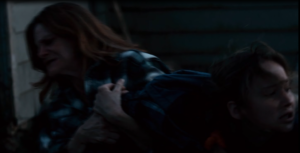
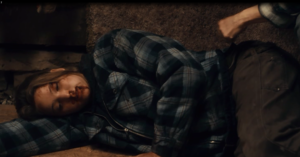
When Teardrop arrives on the scene, he does not have to fight anyone and instead can negotiate to get Ree away and to safety. Later, it is the woman who help Ree by showing her where her father’s body is.
I watched the ‘Making of’ extra on the DVD. It became clear that the film was made with the collaboration of the local community; their houses and animals were used in the film and some of the minor part actors were local people who had never acted before. The close association with the community may account for why the film does not make any overt judgment about the society but rather lets the viewer work out for themselves what the misery of this type of existence does to a person, both positively and negatively.
The second part of the extra showed some footage of the director working with the actors. It was interesting to see that while they were filming, the director would be giving directions to the actors about what to do and where to move. Her voice could clearly be heard, so I can only assume that her voice was removed later or they rerecorded the actors voices later.
Filmography:
Winter’s Bone [feature film, DVD]. Dir. Debra Granik. Anonymous Content, Winter’s Bone Productions, USA. 100 min.
